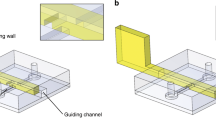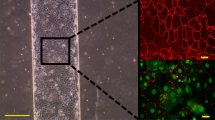Abstract
Robotic multiwell planar patch-clamp has become common in drug development and safety programs because it enables efficient and systematic testing of compounds against ion channels during voltage-clamp. It has not, however, been adopted significantly in other important areas of ion channel research, where conventional patch-clamp remains the favored method. Here, we show the wider potential of the multiwell approach with the ability for efficient intracellular solution exchange, describing protocols and success rates for recording from a range of native and primary mammalian cells derived from blood vessels, arthritic joints and the immune and central nervous systems. The protocol involves preparing a suspension of single cells to be dispensed robotically into 4–8 microfluidic chambers each containing a glass chip with a small aperture. Under automated control, giga-seals and whole-cell access are achieved followed by preprogrammed routines of voltage paradigms and fast extracellular or intracellular solution exchange. Recording from 48 chambers usually takes 1–6 h depending on the experimental design and yields 16–33 cell recordings.
This is a preview of subscription content, access via your institution
Access options
Subscribe to this journal
Receive 12 print issues and online access
$259.00 per year
only $21.58 per issue
Buy this article
- Purchase on Springer Link
- Instant access to full article PDF
Prices may be subject to local taxes which are calculated during checkout




Similar content being viewed by others
References
Hamill, O.P., Marty, A., Neher, B., Sakmann, B. & Sigworth, F.J. Improved patch-clamp techniques for high-resolution current recording from cells and cell-free membrane patches. Pflügers Arch. 391, 85–100 (1981).
Hille, B. Ion Channels of Excitable Membranes. (Sinauer Associates Inc.: Sunderland, Massachusetts, 2001).
Nimigean, C.M. A radioactive uptake assay to measure ion transport across ion channel-containing liposomes. Nat. Protoc. 1, 1207–12 (2006).
Gonzalez, J.E., Oades, K., Leychkis, Y., Harootunian, A. & Negulescu, P.A. Cell-based assays and instrumentation for screening ion-channel targets. Drug Discov. Today 4, 431–439 (1999).
Wolfe, C., Fuks, B. & Chatelain, P. Comparative study of membrane potential-sensitive fluorescent probes and their use in ion channel screening assays. J. Biomol. Screen. 8, 533–543 (2003).
Labarca, P. & Latorre, R. Insertion of ion channels into planar lipid bilayers by vesicular fusion. In Methods in Enzymology. Vol. 207 (eds. Rudy, B. & Iverson, L.E.) 447–463 (Academic Press Inc., London, 1992).
Wang, X. & Li, M. Automated electrophysiology: high throughput of art. Assay Drug Dev. Technol. 1, 695–708 (2003).
Farre, C. et al. Automated ion channel screening: patch clamping made easy. Expert Opin. Ther. Targets 11, 557–565 (2007).
Dunlop, J., Bowlby, M., Peri, R., Vasilyev, D. & Arias, R. High-throughput electrophysiology: an emerging paradigm for ion-channel screening and physiology. Nat. Rev. Drug Discov. 7, 358–368 (2008).
Xu, S.Z. et al. TRPC channel activation by extracellular thioredoxin. Nature 451, 69–72 (2008).
Naylor, J., Milligan, C.J., Zeng, F., Jones, C. & Beech, D.J. Production of a specific extracellular inhibitor of TRPM3 channels. Br. J. Pharmacol. 155, 567–573 (2008).
Li, J. et al. Interactions, functions, and independence of plasma membrane STIM1 and TRPC1 in vascular smooth muscle cells. Circ. Res. 103, e97–104 (2008).
Sigworth, F.J. Electronic design of the patch clamp. In Single-Channel Recording. (eds. Sakmann, B. & Neher, E.) 95–127 (Plenum Press, New York, 1995).
Smith, I.F. et al. Chronic hypoxia potentiates capacitative Ca2+ entry in type-I cortical astrocytes. J. Neurochem. 85, 1109–1116 (2003).
Sotsios, Y. & Ward, S.G. Collection, separation, and activation of human T lymphocytes. In Methods in Molecular Medicine Part III: Human Airway Inflammation. (eds. Rogers, D.F. & Donnelly, L.E.) 205–215 (Humana Press, Springer-Verlag, Totowa, N.J., 2001).
Xu, S.Z. et al. A Sphingosine-1–phosphate-activated calcium channel controlling vascular smooth muscle cell motility. Circ. Res. 98, 1381–9 (2006).
Brown, R.A., Lever, R., Jones, N.A. & Page, C.P. Effects of heparin and related molecules upon neutrophil aggregation and elastase release in vitro . Br. J. Pharmacol. 139, 845–853 (2003).
Jones, N.A., Boswell-Smith, V., Lever, R. & Page, C.P. The effect of selective phosphodiesterase isoenzyme inhibition on neutrophil function in vitro . Pulm. Pharmacol. Ther. 18, 93–101 (2005).
Schneider, U., Schwenk, H.U. & Bornkamm, G. Characterization of EBV-genome negative 'null' and 'T' cell lines derived from children with acute lymphoblastic leukemia and leukemic transformed non-Hodgkin lymphoma. Int. J. Cancer 19, 621–626 (1977).
Kuramoto, T., Werrbach-Perez, K., Perez-Polo, J.R. & Haber, B. Membrane properties of a human neuroblastoma II: effects of differentiation. J. Neurosci. Res. 16, 441–449 (1981).
Ahring, P.K., Strobaek, D., Christophersen, P., Olesen, S.P. & Johansen, T.E. Stable expression of the human large-conductance Ca2+-activated K+ channel α- and β-subunits in HEK293 cells. FEBS Lett. 415, 67–70 (1997).
Jiang, L.-H., Mackenzie, A.B., North, R.A. & Surprenant, A. Brilliant blue G selectively blocks ATP-gated rat P2X7 receptors. Mol. Pharm. 58, 82–88 (2000).
Zeng, F. et al. Human TRPC5 channel activated by a multiplicity of signals in a single cell. J. Physiol. 559, 739–750 (2004).
Fernandez, J.M., Fox, A.P. & Krasne, S. Membrane patches and whole-cell membranes: a comparison of electrical properties in rat clonal pituitary (GH3) cells. J. Physiol. 356, 565–585 (1984).
Kostyuk, P.G., Krishtal, O.A. & Pidoplichko, V.I. Effect of internal fluoride and phosphate on membrane currents during intracellular dialysis of nerve cells. Nature 23, 691–693 (1975).
Tasaki, I. & Takenaka, T. Effects of various potassium salts and proteases upon excitability of intracellularly perfused squid giant axons. Proc. Natl. Acad. Sci. USA 52, 804–810 (1964).
Acknowledgements
This work was primarily supported by grants from the Wellcome Trust. P.S. was supported by an Overseas Research Student Award (UK) and Y.B. by the Egyptian Ministry of Higher Education. We thank Nanion Technologies for good technical support.
Author information
Authors and Affiliations
Corresponding author
Rights and permissions
About this article
Cite this article
Milligan, C., Li, J., Sukumar, P. et al. Robotic multiwell planar patch-clamp for native and primary mammalian cells. Nat Protoc 4, 244–255 (2009). https://doi.org/10.1038/nprot.2008.230
Published:
Issue Date:
DOI: https://doi.org/10.1038/nprot.2008.230
This article is cited by
-
A modern automated patch-clamp approach for high throughput electrophysiology recordings in native cardiomyocytes
Communications Biology (2022)
-
Nanotechnology: new opportunities for the development of patch‐clamps
Journal of Nanobiotechnology (2021)
-
Ascorbate-induced oxidative stress mediates TRP channel activation and cytotoxicity in human etoposide-sensitive and -resistant retinoblastoma cells
Laboratory Investigation (2021)
-
Advances in 3D neuronal microphysiological systems: towards a functional nervous system on a chip
In Vitro Cellular & Developmental Biology - Animal (2021)
-
High throughput screening technologies for ion channels
Acta Pharmacologica Sinica (2016)
Comments
By submitting a comment you agree to abide by our Terms and Community Guidelines. If you find something abusive or that does not comply with our terms or guidelines please flag it as inappropriate.



